Persepolis, also known as Takht-e Jamshid, is a historical treasure in Iran. This UNESCO World Heritage Site offers a captivating glimpse into the opulent Achaemenid Empire, which thrived from 550 to 330 BC. In this guide in Parsi Tours Iran travel agency we will lead you through a journey to explore the marvels of Persepolis, this ancient city.
History of Persepolis
Persepolis, nestled in the Fars province of Iran, is a vivid testament to the grandeur and historical significance of the Achaemenid Empire. Founded by King Darius I in the 6th century BC, this magnificent city served as the empire’s ceremonial capital, embodying its unity and strength.
Situated atop a vast terrace, it boasts monumental structures that narrate the empire’s might and governance through intricate carvings and reliefs. Over approximately 200 years, it became a power and administration symbol.
However, the legacy of
this marvelous place met its twilight in the 4th century BC when Alexander the Great conquered the city, leading to its abandonment. Despite the passage of time, the remnants of it continue to enchant modern-day visitors.
Today, it is a UNESCO World Heritage Site, a beacon of historical significance in the Middle East. The sprawling ruins encompass palaces, temples, and other awe-inspiring structures, including the renowned Apadana, the Hall of a Hundred Columns, and the iconic Gate of Xerxes.
Unveiling the Identity: Naming and Style
This ancient city has had several different names over the centuries. The Persians themselves called it Pārsa, which is also the name of the region of Persia. The Greeks called it Persepolis, which means “city of the Persians” in Greek.
In the Middle Ages, it was known as Čehel-menār, which means “forty minarets” in Persian. This name is likely derived from the many columns still standing at the site. Today, this site is known by its Persian name, Takht-e Jamshīd, which means “throne of Jamshid.” Jamshid is a legendary Persian king who is said to have built the city.
The architecture of this magnificent archeological site is a unique blend of different styles, including Persian, Median, and Babylonian. The Achaemenid kings were able to synthesize these different styles into a new and innovative form of monumental and beautiful architecture.
Architectural Marvels
Takht-e Jamshīd is one of the most impressive archaeological sites in the world, and its architectural wonders serve as a testament to the remarkable craftsmanship and creativity of the Achaemenid Empire. Let’s explore some of this fantastic historical gem’s most prominent architectural elements.
The Gate of All Nations
As you enter Takht-e Jamshīd, the Gate of All Nations greets you warmly. It’s adorned with impressive bull-headed capitals and inscriptions. This monumental gateway was not merely an entrance; it served as the beating heart of the Achaemenid Empire, hosting delegates from many nations. The Gate of All Nations was adorned with reliefs representing the diverse subjects of the empire – a visual testament to its vast dominion. You can glimpse the 23 distinct peoples under the Achaemenid rule within its artful carvings.
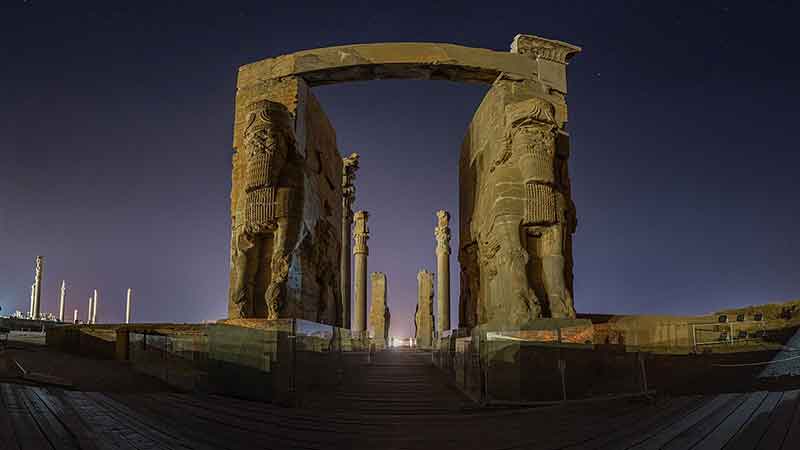
Achaemenid Empire: the Gate of All Nations
Apadana
The Apadana Palace played a vital role in Takht-e Jamshīd. It was the city’s largest and most important building, where the kings held royal audiences and grand celebrations. Foreign dignitaries were welcomed here, and significant ceremonies took place, making it a historic site. The palace had a massive rectangular design with a central hall and two entrances. It boasted an impressive 72 columns, each towering 24 meters. These columns were adorned with reliefs depicting lions, bulls, and scenes of the king receiving tribute, showcasing the empire’s might.
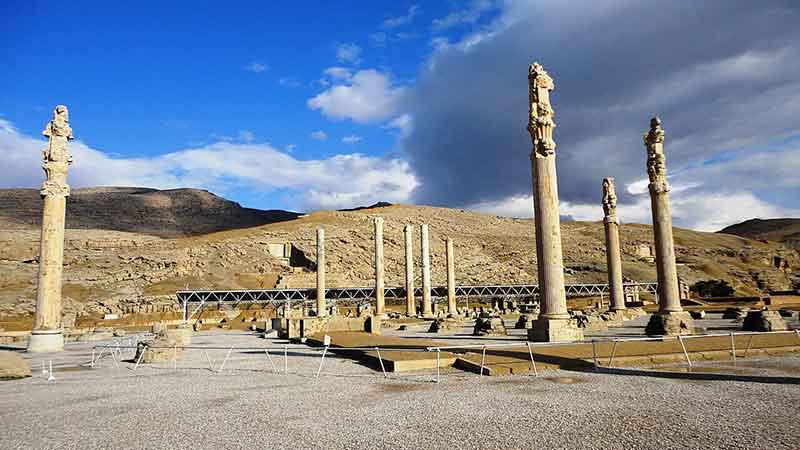
Persepolis: The Apadana Palace
Hall of a Hundred Columns
The Throne Hall, renowned as the Hall of a Hundred Columns, exudes luxury and magnificence. Envision the grandeur of the gatherings and ceremonies that graced its halls. This vast audience hall could accommodate up to 10,000 individuals and was utilized for banquets and other grand assemblies. Adorned with reliefs depicting the king and his courtiers and scenes encompassing hunting and warfare, the Hall of a Hundred Columns offers glimpses into the splendid life of the Achaemenid Empire. It was a place where history was made, and the empire’s power was displayed in all its glory.
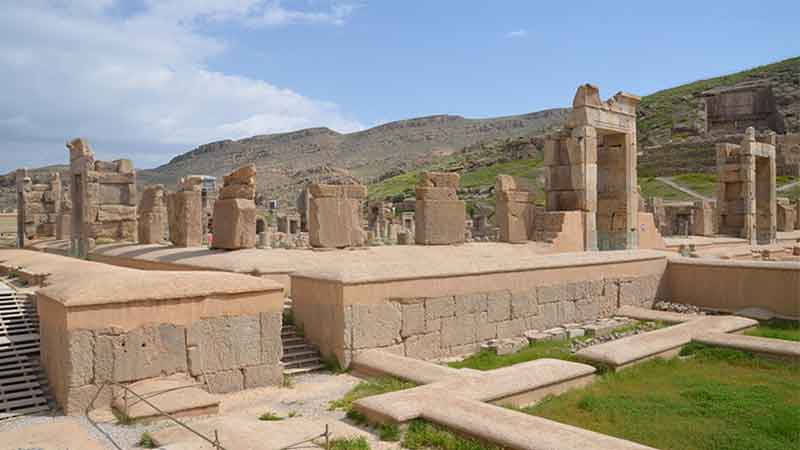
Achaemenid Empire: the Hall of a Hundred Columns
Palace of Darius
The Palace of Darius or Tachara, located on a terrace alongside significant neighbors such as the Apadana, served as the exclusive residence for Achaemenid monarchs. Built-in the 6th century BC by Darius I, this architectural marvel features a grand entrance staircase adorned with soldier and guard reliefs. The rectangular palace, supported by 12 columns, boasts intricate reliefs depicting royal life. It’s one of the best-preserved structures at Takht-e Jamshīd, showcasing Achaemenid culture and engineering prowess.
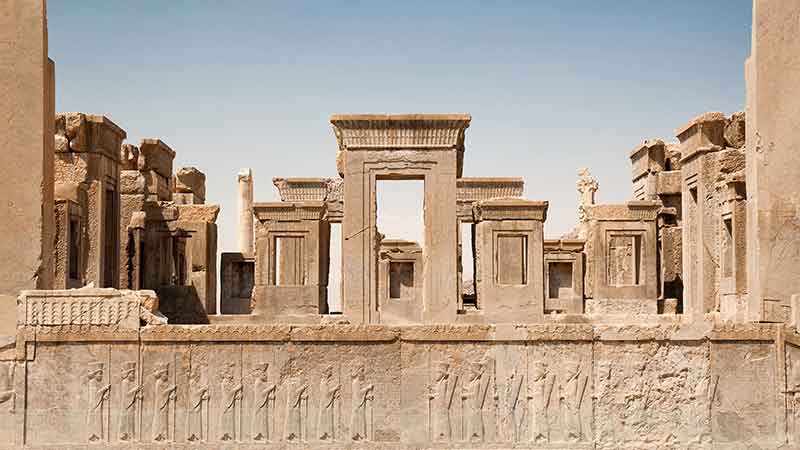
Persepolis: The Palace of Darius
Palace of Xerxes
The Hadish Palace, also known as the Palace of Xerxes, is a standout structure in Takht-e Jamshīd, erected during the 5th century BC by Xerxes I, the fourth Achaemenid Empire ruler famous for his 480 BC Greek invasion. This palace complex boasts interconnected buildings and landscaped gardens, accessed through a grand staircase adorned with soldier and guard reliefs. The central rectangular palace, supported by 36 columns, features intricate reliefs depicting Xerxes, his court, and victorious battles. It is a testament to Achaemenid grandeur and Xerxes’ historical impact in Takht-e Jamshīd.
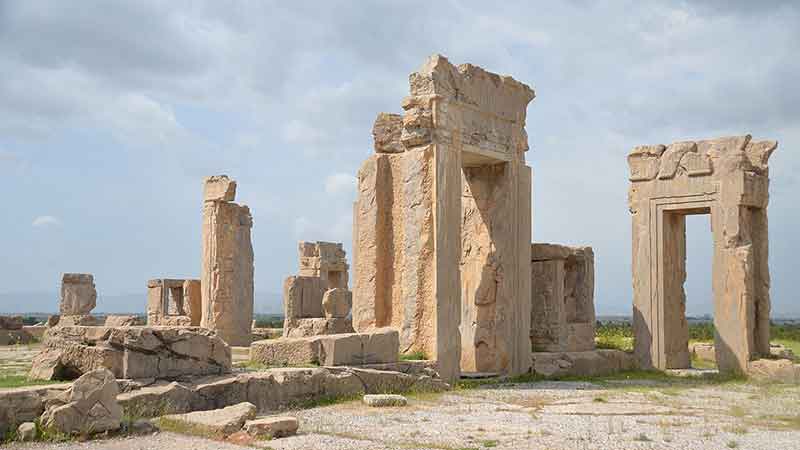
Achaemenid Empire: the Palace of Xerxes
Distinctive Architectural Highlights of Persepolis
Besides its significant structures, Takht-e Jamshīd boasts several noteworthy architectural elements, including:
Artistic Staircases
Takht-e Jamshīd ‘s grand staircases are artistic marvels, not just practical structures. The Grand Staircase leads to the Terrace of Takht-e Jamshīd, flanked by winged bulls symbolizing power. The Apadana Staircase ascends to the main audience hall, adorned with reliefs showcasing opulence. The Xerxes Staircase leads to the Palace of Xerxes, featuring intricate battle scenes. In addition to these significant staircases, some other smaller staircases are fascinating. Beyond function, these staircases vividly depict Achaemenid life, offering a glimpse into the empire’s history and culture.
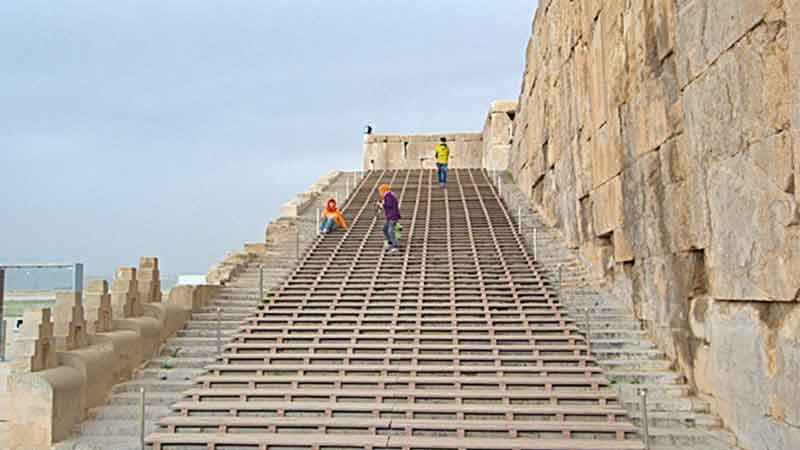
Persepolis: grand staircases
Intricate Reliefs
Takht-e Jamshīd, a prime example of ancient Persian art, reveals its vibrant history through detailed reliefs. These masterpieces meticulously depict regal ceremonies, battles, hunts, and rituals etched into the stone walls of palaces and temples. Renowned for their imposing size and realism, they offer a diverse tableau of subjects and figures, such as the Apadana Staircase Reliefs, portraying the king receiving homage from 23 subject nations, and the Gate of Xerxes Reliefs illustrating royal triumphs. These treasures offer insights into Achaemenid culture, from politics to daily life.
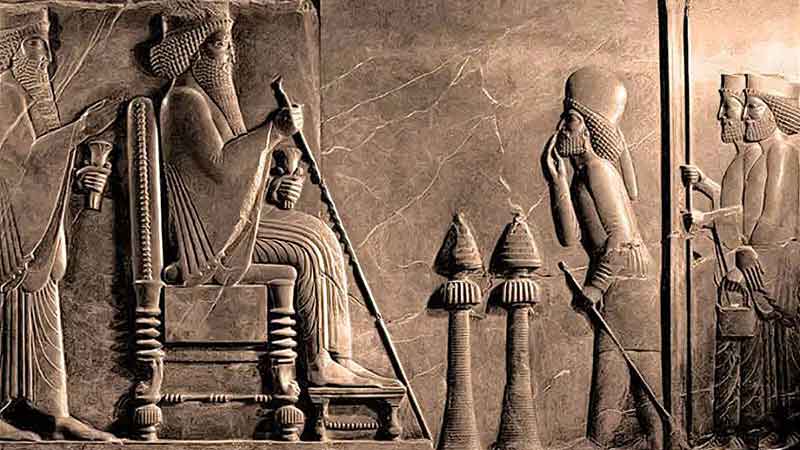
Achaemenid Empire: detailed reliefs
Iconic Columns
The columns at Takht-e Jamshīd are tall and slender with unique double-animal capitals, often depicting bulls but occasionally lions or griffins. These columns served several purposes:
- Supporting roofs
- Adding grandeur to the architecture
- Conveying symbolic messages about the Achaemenid kings’ power
Crafted from locally available limestone, they all share the same height, creating a sense of uniformity and order. The flutes on the column shafts suggest motion, while the double-animal capitals, inspired by Mesopotamian art, contribute to Takht-e Jamshīd’s distinct character.
Persepolis: Iconic Columns
Tips for Travelers
Here are some comprehensive travel tips to enhance your visit:
When to visit?
The best time to visit is spring (March to May) and autumn (September to November). The weather is mild and pleasant during these periods, making it ideal for exploring the archaeological site comfortably. Spring offers blooming landscapes and lush greenery, while autumn provides pleasant temperatures and fewer crowds compared to the hot summer months. Avoid visiting during the scorching summer (June to August) when temperatures can be uncomfortably high, and consider checking local holidays and events that might impact visitor numbers when planning your trip.
How to get there?
To reach Takht-e Jamshīd from Shiraz, you have several options. The most convenient but expensive one is taking a taxi, which you can find at the airport, hotel, or the city center. The ride takes about 45 minutes from Shiraz. Alternatively, public buses depart from Shiraz’s main bus terminal, but they are not very frequent, and the journey takes approximately an hour. You can also join a guided tour from various tour companies in Shiraz. If you’re driving, take the main road to Marvdasht, and you’ll reach Takht-e Jamshīd, about 15 km away.
Opening Hours and Entrance Fee
Takht-e Jamshīd is open for visitors from 8:30 AM to 7:30 PM in spring and summer and from 7:30 AM to 5:30 PM in autumn and winter, with the entrance closing 30 minutes before. The ticket price for foreigners is 100,000 Tomans. How long you spend at the site depends on your interest and walking pace, but plan for at least 2 to 3 hours to explore it thoroughly.
Additional Recommendations
When preparing for your visit to Persepolis, be sure to pack water and snacks. Given the hot and dry climate, protect yourself from the sun with a hat and high-SPF sunscreen. Opt for comfortable shoes, as you’ll cover a lot of ground. Remember your camera to capture the site’s beauty. If you want to delve deeper into the site’s history, consider bringing a guidebook or relevant information. As for attire, dress modestly, covering your shoulders and knees, and choose comfortable, practical clothing and shoes suitable for walking on uneven terrain. And, most importantly, respect the local culture to make the most of your visit.
Conclusion
Your journey to Persepolis promises a remarkable adventure through history, culture, and architectural splendor. As you explore this ancient city, you’ll find yourself transported back in time, marveling at the grandeur of a bygone era. Whether you’re an avid history buff or simply seeking a unique travel experience, this site offers something extraordinary. Take the chance to witness the legacy of the Achaemenid Empire firsthand.






